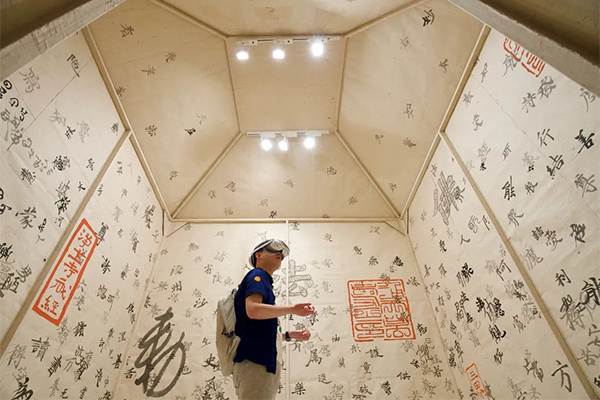 What is On
What is On
A visitor experiences the VR work at the “Amber of History: Reimagining the Library Cave at Dunhuang” exhibition. Photo from Pingshan Art Museum
Exhibitions on the Mogao Grottoes, a UNESCO World Heritage Site in Dunhuang, Northwest China’s Gansu Province, are consistently popular due to Dunhuang’s rich cultural heritage and timeless art. In recent years, the integration of digital technologies and interdisciplinary research has further enriched these exhibitions by offering diverse perspectives on the mysteries and allure of the grottoes.
A new exhibition at the Pingshan Art Museum is offering Shenzheners a unique way to experience the grottoes. Titled “Amber of History: Reimagining the Library Cave at Dunhuang,” the free exhibition features contemporary artworks by Chinese artist and Stanford University art professor Xie Xiaoze.
The showcased ink paintings and sculptures, as well as a video and a virtual reality (VR) work, are the result of Xie’s artist-in-residence program at the Dunhuang Academy in 2017. His project specifically focuses on Cave 17, famously known as “the Library Cave.”

Visitors admire Xie Xiaoze’s artworks at the exhibition. Photos by Cao Zhen unless otherwise stated

A glance at the “Amber of History: Reimagining the Library Cave at Dunhuang” exhibition.
Among the many caves at the Mogao Grottoes decorated with stunning murals and statues, the 7-square-meter Library Cave is notable for its remarkable collection of 50,000 relics, including manuscripts, books, paintings, ritual items and embroidery works dating back to the 4th-11th centuries.
The cave was discovered in 1900 after centuries of concealment, and most of the treasures in the cave were plundered during wars and are now scattered across museums worldwide. These artifacts serve as pivotal sources for comprehending various aspects of ancient China and Central Asia, including historical, religious, cultural, artistic, economic, political, and technological dimensions.
Xie has named his project "Amber of History," viewing the Library Cave as an "amber" preserving the rich heritage of Chinese culture. He initially created a long scroll of ink sketches, notes, diagrams, calligraphy, and drafts that served as a foundation for subsequent sculptures, installations, and paintings within the project. He also visited Shenzhen and Huizhou several times in search of materials for his sculptures.

Xie Xiaoze (3rd L) introduces his artworks to visitors during the exhibition opening Oct. 26. Photo from Pingshan Art Museum

A visitor admires an artwork at the exhibition.
During the exhibition's opening weekend, many visitors were captivated by a VR experience. By standing inside an installation resembling the Library Cave, visitors can embark on a fantastic virtual journey to explore the ancient site filled with exquisite relics.
Another striking exhibit consists of colorful sculptures shaped like the Library Cave, with some bearing embedded Chinese characters from Buddhist manuscripts, creating an effect of characters floating in an ethereal realm. This artistic fusion of ancient craftsmanship and modern innovation conveys a sense of “time capsules” that safeguard the profound cultural heritage of Dunhuang.
In the “Eastern and Western Cosmologies” ink scroll, Xie combines scenes from the “Three Realms and Nine Levels Diagram” in Dunhuang with Dante's “The Divine Comedy,” reflecting his contemplation on life and death. The artist aims to trigger dialogues and explore resonances between Chinese and Western artistic expressions on these profound themes.

Visitors observe “Amber of History Series Sculpture.”

Visitors admire Xie Xiaoze’s artworks at the exhibition.
Visitors are invited to delve into the historical, cultural, and philosophical significance of the Mogao Grottoes through other exhibits, such as a video work titled “Beholding Absence,” shown in a tiny space reminiscent of the entrance to the small Library Cave.
The exhibition’s curator, Wu Hung, underscores the fresh perspective it brings, emphasizing its “reimagining” of historical resources through a contemporary lens. “Dunhuang is a wellspring of artistic inspiration, drawing numerous artists to craft interpretations of its enduring legacy. I’m impressed by Xie’s experimental approach, which challenges the conventional understanding of Dunhuang’s cultural legacy,” he said.
Hours: 9 a.m.-5 p.m., closed Mondays
Tickets: Free, no reservations are necessary
Venue: Pingshan Art Museum, Pingshan District (坪山区坪山美术馆)
Metro: Line 14 to Pingshan Square Station (坪山广场站), Exit D1